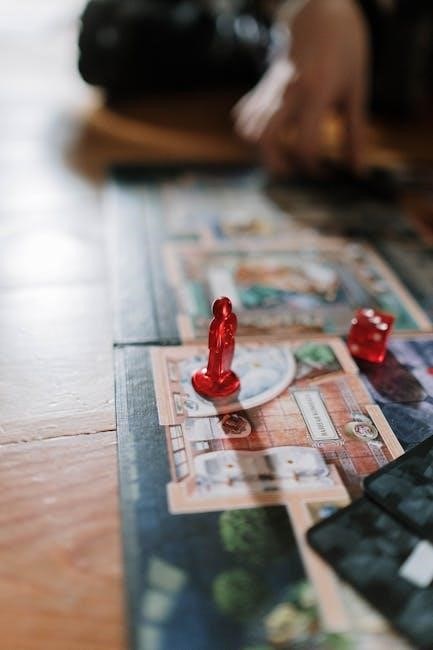Discover the essentials of table shuffleboard with our comprehensive guide. Learn official rules, scoring systems, and setup requirements. Perfect for beginners and experienced players alike, this resource ensures fair and enjoyable gameplay for all.
Overview of the Game and Its Objective
Table shuffleboard is a fun and strategic game where players slide weighted discs across a smooth surface, aiming to score points by reaching specific zones. The objective is to outscore your opponent by landing your discs farther down the table or knocking theirs off. Games are typically played to 15 or 21 points, with players alternating turns. Strategy involves precision, distance control, and cleverly positioning your discs to maximize points while defending against opponents. The game requires skill, focus, and a mix of luck, making it enjoyable for all ages and skill levels.
Importance of Understanding the Rules for Beginners
Understanding the rules of table shuffleboard is crucial for beginners to ensure a smooth and enjoyable experience. Clear knowledge of setup, gameplay flow, and scoring prevents confusion and disputes. It also helps players develop strategies early on. While the basic rules are simple, mastering them builds a strong foundation for improving skills. Adhering to the rules fosters fair play and sportsmanship, making the game accessible and fun for everyone involved. Starting with a solid understanding ensures that beginners can focus on skill development and strategic thinking from the very first game.

Core Rules of Table Shuffleboard
Grasp the fundamental principles of table shuffleboard, including puck placement, alternating turns, and scoring zones. Understand setup requirements and essential gameplay elements for a smooth experience.
Setup and Equipment Requirements
A standard shuffleboard table measures 22 feet in length and 20 inches in width, typically made of polished wood. The playing surface must be smooth and even, with scoring zones clearly marked. Players use four weights (or pucks) per side, colored to distinguish teams or players. Additional equipment includes a cue stick for shooting and wax for reducing friction. The table is equipped with gutters on both sides to remove pucks that fall off. Proper setup ensures fair and enjoyable gameplay, with the tournament director adjusting the table as needed for optimal conditions.
Gameplay Flow and Basic Scoring Mechanisms
Players take turns sliding their weights across the table, aiming to land them in high-scoring zones or knock opponents’ weights off. Each round ends when all weights are shot. Points are awarded based on the distance each weight travels, with bonus points for landing in advanced zones. Only the leading player’s weights score, calculated by their distance beyond the opponent’s farthest weight. Knocking off an opponent’s weight can reduce their score. The goal is to reach a predetermined score, typically 15 or 21 points, to win the game.
Popular Game Variations
- Knock Off: A simple, casual format where players aim to knock opponents’ weights off the table.
- Horse Collar: A high-scoring, competitive game with unique betting elements and strategic plays.
- Crazy Eight: A challenging variation with unique scoring rules and deep strategic elements.
- Target Game: Focuses on precision, with players aiming for specific targets on the table.
Knock Off: Simplified Rules for Casual Play
Knock Off is a straightforward and enjoyable variation of table shuffleboard, ideal for casual play. Players alternate turns sliding their weights toward the opposite end of the table, aiming to get their weights farther than their opponent’s. The goal is to knock off the opponent’s weights or position yours in the highest-scoring zones. This version is perfect for beginners, as it focuses on basic strategies like distance and accuracy. Games are typically played to 15 points, making it a quick and fun experience for all skill levels.
Horse Collar: High-Scoring and Competitive Format
Horse Collar is a dynamic and competitive shuffleboard variation, often played one-on-one or in teams. The goal is to reach 51 points, with a focus on strategic shots and high-scoring opportunities. This format introduces a betting element, where players can wager on their ability to score, adding excitement to the game. Unique scoring shots, like the 26-point “Horse Collar,” make it a favorite for experienced players seeking a challenge. Its fast-paced nature ensures thrilling matches and requires precision and tactical thinking.
Crazy Eight: Unique Scoring and Strategic Depth
Crazy Eight is a variation of table shuffleboard known for its unique scoring system and strategic depth. While it shares similarities with classic shuffleboard in terms of gameplay mechanics, the scoring process introduces new challenges and opportunities for players. This variation is particularly popular among those who enjoy a mix of luck and strategy, as it requires careful planning to maximize points. The unique scoring twists in Crazy Eight make it a favorite for players looking to enhance their shuffleboard experience with added complexity and fun, ensuring engaging gameplay for all participants.
Target Game: Precision and Accuracy Challenges
The Target Game is a thrilling variation of table shuffleboard that emphasizes precision and accuracy. Drawing inspiration from games like darts and archery, players aim to land their weights in specific scoring zones on the table. Each target area holds a different point value, challenging players to strategize and aim carefully. Only the winner of each round scores points, adding a competitive edge. This format requires skill and focus, making it a favorite for those who enjoy testing their accuracy and tactical abilities in a fun, challenging way.

Scoring in Table Shuffleboard
Scoring in table shuffleboard is based on the distance your weights land on the table. Points are awarded according to predefined zones. Only the farthest weight scores if it leads; if all your weights are ahead, each beyond the opponent’s farthest scores. Accuracy and strategy are key to securing higher points.
Basic Scoring Principles and Zone Values
Scoring in table shuffleboard is determined by the distance your weights land on the board. The table is divided into zones with increasing point values: 1, 2, 3, 4, and 7 points. A weight must cross the foul line to count. Only the player with the farthest weight scores, with points awarded for each of their weights beyond the opponent’s farthest. If no weights are in scoring zones, the closest weight scores 1 point. Penalties, like falling off the table, deduct points, ensuring strategic play and accuracy are crucial.
Advanced Scoring Techniques and Strategies
Mastering advanced techniques enhances scoring potential. Positioning weights strategically can maximize points while minimizing opponents’ opportunities. Knocking off opponents’ weights can disrupt their scoring and create openings. Using your weights to block or shield high-value positions adds a tactical layer. Understanding weight placement and control allows precise targeting of high-point zones. Seasoned players often employ psychological strategies to unsettle opponents, further refining their gameplay. These advanced methods require practice and foresight to execute effectively, elevating your play to a competitive level and ensuring consistent high scores.
Penalties and Fouls
Fouls, such as intentional out-of-turn shooting or table harassment, result in penalties. Unsportsmanlike conduct or equipment misuse can lead to point deductions or disqualification, ensuring fair play.
Common Penalties and Their Consequences
Common penalties include shooting out of turn, intentionally hitting or shaking the table, and harassment. Consequences range from point deductions to loss of turn. Repeated offenses may lead to disqualification, ensuring fair play and sportsmanship. These rules maintain the integrity of the game and promote a respectful environment for all players.
Harassment and Unsportsmanlike Conduct Rules
Harassment and unsportsmanlike conduct are strictly prohibited. This includes verbal or physical intimidation, bullying, and disruptive behavior. Such actions may result in warnings, penalties, or disqualification. Maintaining a respectful and fair environment is crucial for enjoyable gameplay. Officials enforce these rules to ensure all players can participate without fear of mistreatment. Sportsmanship is essential to upholding the spirit of the game and fostering positive competition among players.

Advanced Strategies for Experienced Players
Master weight placement and knock-offs to outmaneuver opponents. Employ psychological tactics like mind games and strategic positioning to gain a competitive edge in high-level play.
Mastering Weight Placement and Knock-Offs
Mastering weight placement involves strategically positioning pucks to maximize scoring opportunities while minimizing opponents’ chances. Knock-offs require precision to dislodge opponents’ pucks without compromising your own. Experienced players often use weighted strategies to protect high-scoring pucks and create barriers. Psychological tactics, such as intimidating shots, can unsettle opponents. Advanced techniques include using spin and angle control to achieve optimal puck placement. Practicing these skills enhances gameplay and elevates your competitive edge, making you a formidable player at the table.
Psychological Aspects and Mind Games in Shuffleboard
Psychological tactics play a crucial role in shuffleboard, as players often use mind games to unsettle opponents. Experienced players employ strategies like intimidating shots, strategic positioning, and maintaining focus under pressure. These mental strategies can influence opponents’ decisions and performance. Mastering psychological aspects enhances gameplay by creating an edge, allowing players to outthink and outmaneuver their rivals. Mental resilience and confidence are key to staying composed during high-stakes moments, ultimately elevating your competitive edge.

Equipment and Table Maintenance
A standard shuffleboard table measures 22 feet long and 20 inches wide. Regular maintenance, including cleaning and waxing, ensures smooth gameplay and prolongs equipment lifespan.
Standard Table Dimensions and Surface Requirements
A standard shuffleboard table measures 22 feet in length and 20 inches in width. The playing surface is typically made of smooth, polished wood, often maple, to ensure minimal friction. The table must be level and free from warping to maintain fair play. The surface is coated with silicone beads to reduce friction, allowing pucks to glide smoothly. Scoring zones are marked at 7, 8, 9, and 10 points, with clear lines designating the foul line and the seven-off line. Proper dimensions and surface quality are essential for accurate gameplay.
Caring for Your Shuffleboard Table and Accessories
Regularly clean the shuffleboard surface with a soft cloth and mild detergent to prevent dust buildup. Apply silicone beads or shuffleboard wax to maintain smooth puck movement. Store pucks and accessories in a dry place to avoid rust or damage. Avoid harsh chemicals, as they can scratch the finish. Inspect the table periodically for warping or unevenness and adjust as needed. Proper care extends the lifespan of your equipment and ensures optimal gameplay. Always follow manufacturer guidelines for maintenance and repairs.
Tournament Play and Official Rules
Tournament shuffleboard follows structured competitive formats, with the director ensuring fair play by adjusting tables and resolving disputes. Rules are strictly enforced for balanced and exciting matches.
Structure of Competitive Matches and Scoring Systems
Competitive matches in table shuffleboard are typically played in a best-of-three format, with players alternating turns. Scoring systems vary, but most games aim to reach 15 or 21 points. Points are awarded based on puck placement in scoring zones, with bonuses for strategic moves like knocking off opponents. The tournament director ensures fair play, adjusting tables as needed, and resolving disputes to maintain a balanced and exciting competition.
Role of the Tournament Director and Dispute Resolution
The tournament director ensures fair play by adjusting tables, enforcing rules, and resolving disputes. They exercise judgment in unforeseen situations, maintaining the game’s integrity. Disputes are addressed through clear communication, with decisions often final. Penalties or score adjustments may result from rule violations or harassment. The director’s role is crucial for a smooth, competitive environment, ensuring all players adhere to official guidelines and sportsmanship standards throughout the match.

Downloading and Using Table Shuffleboard Rules PDF
Access official table shuffleboard rules PDF guides from trusted sources like McClure Tables or the Shuffleboard Federation. These resources provide detailed rules, scoring charts, and setup instructions for easy reference, ensuring accurate gameplay and fair competition.
Official Sources for Rules and Scoring Charts
Official table shuffleboard rules and scoring charts are available from reputable sources like the Shuffleboard Federation and McClure Tables. These resources offer comprehensive guides, ensuring accuracy and consistency. They include detailed rules for various game formats, setup requirements, and scoring mechanisms. Players can download PDF versions for easy reference, making it simple to understand and apply the rules during gameplay. These official documents are essential for both casual and competitive play, providing a clear framework for enjoying shuffleboard.
Benefits of Having a Printable Rules Reference
A printable rules reference offers convenience and accessibility for players. It provides a clear, tangible guide during games, ensuring everyone understands the rules. This resource is particularly useful for newcomers, helping them learn and apply the rules effectively. having a physical copy also fosters fair play and reduces disputes. Whether for casual play or tournaments, a printable rules reference is an invaluable tool for enhancing the overall shuffleboard experience and ensuring smooth, enjoyable gameplay for all participants.

Common Mistakes to Avoid for New Players
Common mistakes include improper weight placement and shooting out of turn. Avoid these errors to ensure fair play and improve your shuffleboard experience effectively.
Understanding the Basics to Improve Your Game
Mastering the fundamentals is crucial for success in table shuffleboard. Start by learning the objective: slide your weights into scoring zones while knocking off opponents’. Understand the setup, including the table dimensions and equipment. Familiarize yourself with basic rules, such as alternating turns and scoring mechanisms. Practice proper shooting techniques to control distance and accuracy. Avoid common mistakes like shooting out of turn or improper weight placement. By grasping these essentials, you’ll build a solid foundation for advancing your skills and enjoying the game fully.
Practicing Proper Shooting and Strategy
Refine your technique by focusing on grip, stance, and follow-through. Practice sliding weights with consistent force to master distance control. Develop strategies like knocking off opponents’ pucks or blocking their path. Study the board layout to optimize scoring opportunities. Regular practice enhances accuracy and game sense. Learn to adapt your approach based on the game’s progression and your opponents’ moves. Improving these skills will elevate your gameplay and increase your chances of winning.
Master the art of table shuffleboard by embracing its rules and strategies. Enjoy the game, refine your skills, and make every match a fun-filled experience.
Final Tips for Enjoying Table Shuffleboard
To maximize your table shuffleboard experience, practice patience and strategy; Start with basic rules, then explore advanced techniques. Experiment with different game variations like Knock Off or Horse Collar to keep play exciting. Always maintain fair play and sportsmanship. Regular practice will help refine your skills and enhance your enjoyment. Whether playing casually or competitively, embracing the rules and strategies ensures a fun and rewarding experience for all players.
Encouragement to Explore Advanced Techniques
Once comfortable with the basics, dive into advanced strategies like weight placement and knock-offs to elevate your game. Experiment with high-scoring formats such as Horse Collar or Crazy Eight for added challenge. Mastering these techniques not only enhances your gameplay but also unlocks new levels of fun and competition. Don’t hesitate to explore psychological tactics to outsmart opponents. With practice and confidence, you’ll become a formidable player, ready to take on any shuffleboard challenge with skill and precision.




